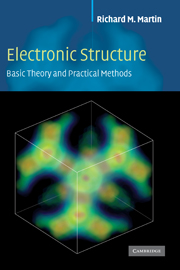Book contents
- Frontmatter
- Contents
- Preface
- Acknowledgments
- Notation
- Part I Overview and background topics
- Part II Density functional theory
- Part III Important preliminaries on atoms
- Part IV Determination of electronic structure: the three basic methods
- 12 Plane waves and grids: basics
- 13 Plane waves and grids: full calculations
- 14 Localized orbitals: tight-binding
- 15 Localized orbitals: full calculations
- 16 Augmented functions: APW, KKR, MTO
- 17 Augmented functions: linear methods
- Part V Predicting properties of matter from electronic structure – recent developments
- Appendix A Functional equations
- Appendix B LSDA and GGA functionals
- Appendix C Adiabatic approximation
- Appendix D Response functions and Green's functions
- Appendix E Dielectric functions and optical properties
- Appendix F Coulomb interactions in extended systems
- Appendix G Stress from electronic structure
- Appendix H Energy and stress densities
- Appendix I Alternative force expressions
- Appendix J Scattering and phase shifts
- Appendix K Useful relations and formulas
- Appendix L Numerical methods
- Appendix M Iterative methods in electronic structure
- Appendix N Code for empirical pseudopotential and tight-binding
- Appendix O Units and conversion factors
- References
- Index
13 - Plane waves and grids: full calculations
from Part IV - Determination of electronic structure: the three basic methods
Published online by Cambridge University Press: 05 June 2012
- Frontmatter
- Contents
- Preface
- Acknowledgments
- Notation
- Part I Overview and background topics
- Part II Density functional theory
- Part III Important preliminaries on atoms
- Part IV Determination of electronic structure: the three basic methods
- 12 Plane waves and grids: basics
- 13 Plane waves and grids: full calculations
- 14 Localized orbitals: tight-binding
- 15 Localized orbitals: full calculations
- 16 Augmented functions: APW, KKR, MTO
- 17 Augmented functions: linear methods
- Part V Predicting properties of matter from electronic structure – recent developments
- Appendix A Functional equations
- Appendix B LSDA and GGA functionals
- Appendix C Adiabatic approximation
- Appendix D Response functions and Green's functions
- Appendix E Dielectric functions and optical properties
- Appendix F Coulomb interactions in extended systems
- Appendix G Stress from electronic structure
- Appendix H Energy and stress densities
- Appendix I Alternative force expressions
- Appendix J Scattering and phase shifts
- Appendix K Useful relations and formulas
- Appendix L Numerical methods
- Appendix M Iterative methods in electronic structure
- Appendix N Code for empirical pseudopotential and tight-binding
- Appendix O Units and conversion factors
- References
- Index
Summary
Summary
The subject of this chapter is the role of plane waves and grids in modern electronic structure calculations, which builds upon the basic formulation of Ch. 12. Plane waves have played an important role from the early OPW calculations to widely used methods involving norm-conserving pseudopotentials. Plane waves continue to be the basis of choice for many new developments, such as quantum molecular dynamics simulations (Ch. 18), owing to the simplicity of operations. Efficient iterative methods (App. M) have made it feasible to apply plane waves to large systems, and recently developed approaches such as “ultrasoft” pseudopotentials and projector augmented waves (PAWs Ch. 11) have made it feasible to apply plane waves to difficult cases such as materials containing transition metals. Real-space grids are an intrinsic part of efficient planewave calculations and there is a growing development of real-space methods, including multigrids, finite elements, wavelets, etc.
Basic Schrödinger-like equations for eigenstates expanded in a plane wave basis can be found in Sec. 12.1 and related equations for real-space grids in Sec. 12.8. These methods are appropriate in cases where the potentials and wavefunctions are smooth. Thus application of these methods to real materials means that they must be combined with a transformation to remove the core states, such as OPWs, pseudopotentials, or PAWs (Ch. 11). Many aspects of pseudopotential calculations have been given in Sec. 12.6.
- Type
- Chapter
- Information
- Electronic StructureBasic Theory and Practical Methods, pp. 254 - 271Publisher: Cambridge University PressPrint publication year: 2004



